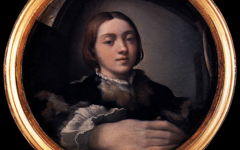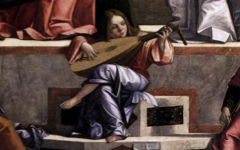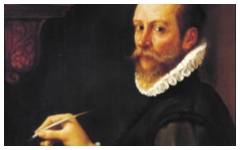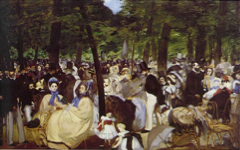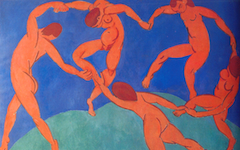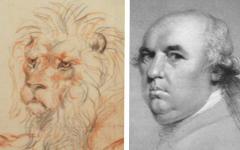Music as Art
Music as a metaphor for the creative act has been an iconic metaphor in the visual arts since at least the Renaissance, readily recognized by visual artists in all periods yet unseen by others. For example, female artists in the sixteenth century instead of painting their self-portraits laboring at a demeaning, manual craft showed themselves at a keyboard performing music. Sofonisba Anguissola, Lavinia Fontana and Tintoretto’s daughter, Marietta, all did so. Yet although music is well-known and widely accepted as a metaphor for visual art in the work of individual painters, such as Courbet playing instruments in his early self-portraits or Matisse with his violin{ref1}, it is still largely unrecognized as a metaphor common to poetic painters in general.
Most Recent Articles
Artists often identify with other artists, using them as an alter ego. Here is an exceptionally clever one.
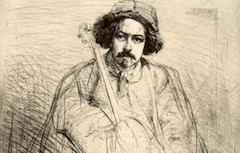
Whistler’s J. Becquet, Sculptor (1859)
All Articles (Alphabetical by Artist, then Title)
Learn how additions to a painting's narrative often provide access to the composition's underlying meaning
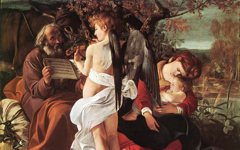
Caravaggio’s Rest on the Flight into Egypt (c.1597)
How Daumier turned a kettle-drum into symbols...
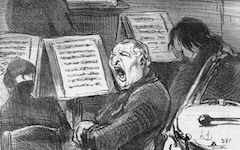
Daumier’s The Orchestra.. ..During A Tragedy (1852)
Learn how an artist can link himself through music to great painters before him
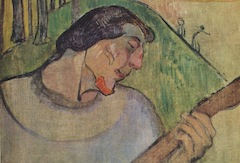
Gauguin’s Self-portrait with a Mandolin (1889) and The Player Schneklud (1894)
How an artist, the artist's lover, is Ingres' own androgynous reflection
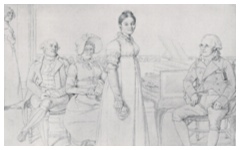
Ingres’ The Forestier Family (1806)
How painters can imagine themselves as violinists and other musical performers
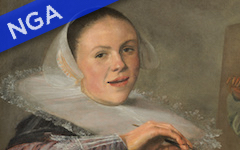
Leyster’s Self-portrait at the Easel (c.1630)
A 20th-century version of medieval angels playing stringed instruments. See how.

Lichtenstein’s Girl with an Accordion (1961)
A pipe may be a pipe for René Magritte but a piano is not a piano for Roy Lichtenstein

Lichtenstein’s Piano (c.1961)
Don't forget to imagine what can't be seen: the artist's viewpoint
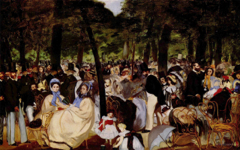
Manet’s Music in the Tuileries (1862)
A good example of how the "errors" in a painting are really the key to its meaning
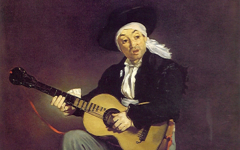
Manet’s The Spanish Singer (1860)
Learn how Picasso bases an image on the letters of his signature
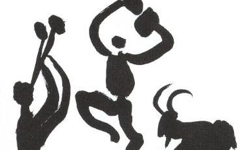
Picasso’s Musician, Dancer, Goat and Bird (1959)
Genres are an artificial classification of little meaning. For instance, as here, still-life without life would be still-born.
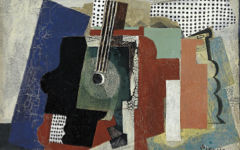
Picasso’s Still-Life with Door, Guitar and Bottles (1916)
If you like Renoir but can't see Raphael, you won't see Renoir's Raphael

Renoir’s Dance in the Country (1883)
Get to know what painters and sculptors look like at work - and their various processes - and your brain will penetrate the surface of a painting in no time. A painting like this one...

Titian’s Shepherd and Nymph (c.1575-6)
There is more to Vermeer than a pretty scene and dull symbolism

Vermeer’s The Love Letter (c.1669-70)
Sometimes one of the secrets of art is so obvious, no-one sees it

Veronese’s The Marriage at Cana (1563)
Artists often identify with other artists, using them as an alter ego. Here is an exceptionally clever one.

Whistler’s J. Becquet, Sculptor (1859)
© Simon Abrahams. Articles on this site are the copyright of Simon Abrahams. To use copyrighted material in print or other media for purposes beyond 'fair use', you must obtain permission from the copyright owner. Websites may link to this page without permission (please do) but may not reproduce the material on their own site without crediting Simon Abrahams and EPPH.
